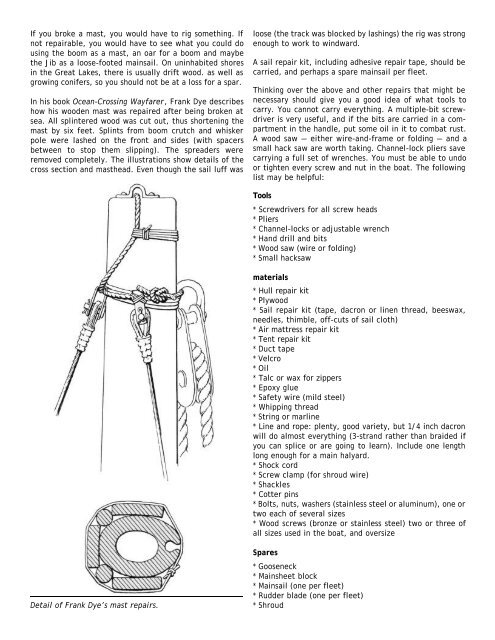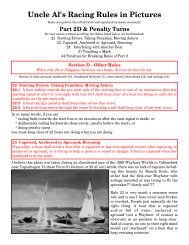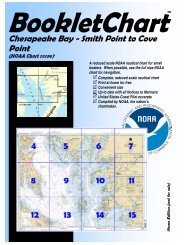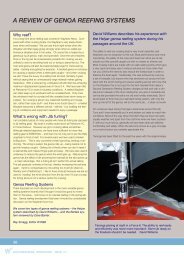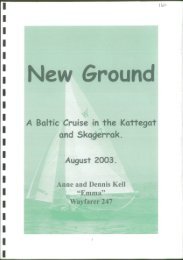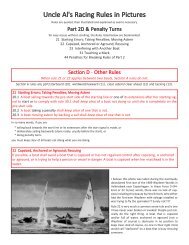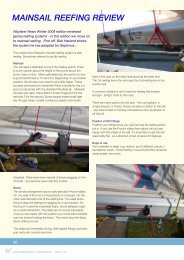Contents - Wayfarer Institute of Technology
Contents - Wayfarer Institute of Technology
Contents - Wayfarer Institute of Technology
Create successful ePaper yourself
Turn your PDF publications into a flip-book with our unique Google optimized e-Paper software.
If you broke a mast, you would have to rig something. If<br />
not repairable, you would have to see what you could do<br />
using the boom as a mast, an oar for a boom and maybe<br />
the Jib as a loose-footed mainsail. On uninhabited shores<br />
in the Great Lakes, there is usually drift wood. as well as<br />
growing conifers, so you should not be at a loss for a spar.<br />
In his book Ocean-Crossing <strong>Wayfarer</strong>, Frank Dye describes<br />
how his wooden mast was repaired after being broken at<br />
sea. All splintered wood was cut out, thus shortening the<br />
mast by six feet. Splints from boom crutch and whisker<br />
pole were lashed on the front and sides (with spacers<br />
between to stop them slipping). The spreaders were<br />
removed completely. The illustrations show details <strong>of</strong> the<br />
cross section and masthead. Even though the sail luff was<br />
loose (the track was blocked by lashings) the rig was strong<br />
enough to work to windward.<br />
A sail repair kit, including adhesive repair tape, should be<br />
carried, and perhaps a spare mainsail per fleet.<br />
Thinking over the above and other repairs that might be<br />
necessary should give you a good idea <strong>of</strong> what tools to<br />
carry. You cannot carry everything. A multiple-bit screwdriver<br />
is very useful, and if the bits are carried in a compartment<br />
in the handle, put some oil in it to combat rust.<br />
A wood saw — either wire-and-frame or folding — and a<br />
small hack saw are worth taking. Channel-lock pliers save<br />
carrying a full set <strong>of</strong> wrenches. You must be able to undo<br />
or tighten every screw and nut in the boat. The following<br />
list may be helpful:<br />
Tools<br />
* Screwdrivers for all screw heads<br />
* Pliers<br />
* Channel-locks or adjustable wrench<br />
* Hand drill and bits<br />
* Wood saw (wire or folding)<br />
* Small hacksaw<br />
materials<br />
* Hull repair kit<br />
* Plywood<br />
* Sail repair kit (tape, dacron or linen thread, beeswax,<br />
needles, thimble, <strong>of</strong>f-cuts <strong>of</strong> sail cloth)<br />
* Air mattress repair kit<br />
* Tent repair kit<br />
* Duct tape<br />
* Velcro<br />
* Oil<br />
* Talc or wax for zippers<br />
* Epoxy glue<br />
* Safety wire (mild steel)<br />
* Whipping thread<br />
* String or marline<br />
* Line and rope: plenty, good variety, but 1/4 inch dacron<br />
will do almost everything (3-strand rather than braided if<br />
you can splice or are going to learn). Include one length<br />
long enough for a main halyard.<br />
* Shock cord<br />
* Screw clamp (for shroud wire)<br />
* Shackles<br />
* Cotter pins<br />
* Bolts, nuts, washers (stainless steel or aluminum), one or<br />
two each <strong>of</strong> several sizes<br />
* Wood screws (bronze or stainless steel) two or three <strong>of</strong><br />
all sizes used in the boat, and oversize<br />
Detail <strong>of</strong> Frank Dye’s mast repairs.<br />
Spares<br />
* Gooseneck<br />
* Mainsheet block<br />
* Mainsail (one per fleet)<br />
* Rudder blade (one per fleet)<br />
* Shroud


